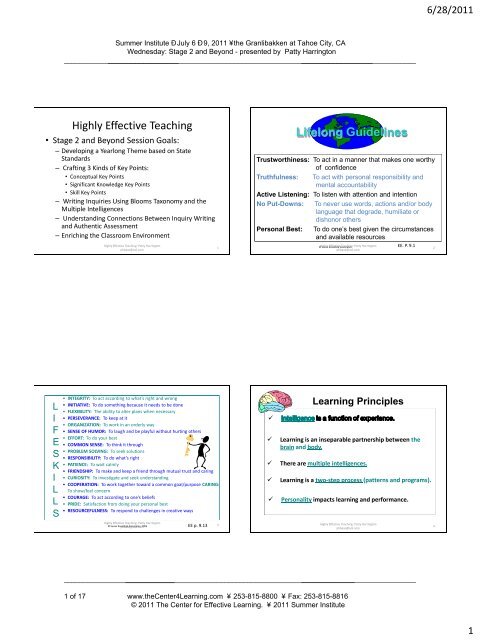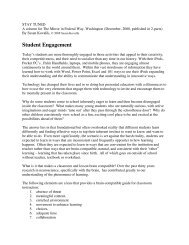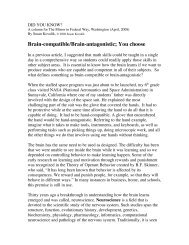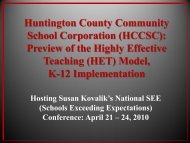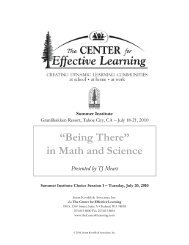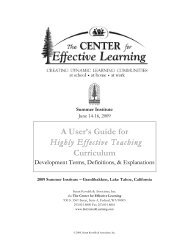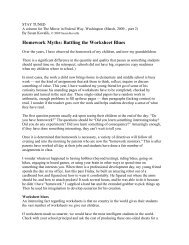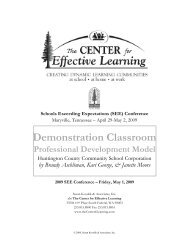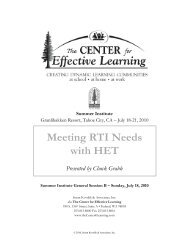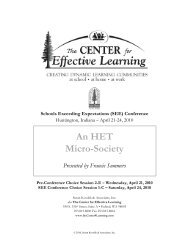PDF Stage 2 - Susan Kovalik & Associates
PDF Stage 2 - Susan Kovalik & Associates
PDF Stage 2 - Susan Kovalik & Associates
Create successful ePaper yourself
Turn your PDF publications into a flip-book with our unique Google optimized e-Paper software.
6/28/2011Summer Institute Ð July 6 Ð 9, 2011 ¥ the Granlibakken at Tahoe City, CAWednesday: <strong>Stage</strong> 2 and Beyond - presented by Patty Harrington___________________________________________________________________Creating a Yearlong ThemeBODY-MAPPING:Parts of a ThemeKidGrabberTopicsThe purpose of a yearlong theme is aserious one.• Primarily its role is to enhance the brain’ssearch for patterns and meaning by creating agiant pattern, like a large mental web.Concept(body of theme)Keypoints(point out)• The theme provides an “address” in the brainfor processing and retaining the knowledge andskills for the entire year.By Judy EackerSKA AssociateYearlong ThemeHighly Effective Teaching: Patty Harrington9Highly Effective Teaching: Patty Harringtonphbase@aol.com 10phbase@aol.comTopics1. Discovering Me!Journey to Command Central (brain, senses)We are Family (living/working together)Living in the Pile (Ant Homes)Location: SchoolConcept: Identity2. Exploring Our Colorful WorldLiving in the Hole (Tree Homes)Season Mine With Color (seasonal change)Have to Have a Habitat (Terrariums)Celebrating US (American events)Location: Pumpkin Patch, speakerConcept: NatureTaking ActionThe goals of this stage of group development are to:Strengthen the sense of belonging through workingtogether to accomplish an agreed upon task3. InvestigatingOur UniquenessThe World is a Rainbow (cultures- various regions)You Can Count on Me (Penguins & their young)Location: Zoo, Koger Center, speakerConcept: Similarities and Differences4. Managing Our RTE WorldWhat Comes Around Goes Around (ecology)―Egg-ceptional‖ (Eggs)Frog and Friends (Pond Life)Location: Recycling Center, PettingZoo, speakerConcept: EnvironmentOrganizing Concept: Relationships are the special types of properties or connections that define how two or more objects areassociated with each otherRationale: You, me, and the world makes three!Developed by: Round Top Elementary School Kindergarten TeamGive students practice in applying the personal andsocial skills needed to create and maintain commongroundProvide practice using the concepts and skills ofour curriculum in real-world situationsGive students practice using the levers of ourdemocratic society to affect change for the commongoodHighly Effective Teaching: Patty HarringtonExceeding Expectations by <strong>Susan</strong> J. <strong>Kovalik</strong> & Karen D. Olsen pgs 9.612phbase@aol.com___________________________________________________________________________________________________________________3 of 17www.theCenter4Learning.com ¥ 253-815-8800 ¥ Fax: 253-815-8816© 2011 The Center for Effective Learning. ¥ 2011 Summer Institute3
6/28/2011Summer Institute Ð July 6 Ð 9, 2011 ¥ the Granlibakken at Tahoe City, CAWednesday: <strong>Stage</strong> 2 and Beyond - presented by Patty Harrington___________________________________________________________________Kindergarten Yearlong ThemeDiscovering Me Exploring the Component Colorful Investigating OurManaging Our RTE WorldWorld Around Me UniquenessConcept Identity Nature Similarities and Differences EnvironmentBeing There School Pumpkin Patch Zoo, Koger Center Petting Zoo; RecyclingExperience (s)CenterGuest SpeakersWild Birds Unlimited, Dentist; guest readers Ms. Kastner- entomologistFire TruckI. Planting the SeedsIntroducing… Me! (LLG/LS, brain, MI)Family Trees (heritage)Smarty Plants (needs, structures, cycle)May the Force Be With You! (force and motion)Being There: Harmon’s Tree FarmConcept: DiscoveryService Project: School GardensII. Sprouting UpWe Make a Difference (responsiblecitizens, community helpers)Farm to Market (economics)Being There: Fabulous Fall Festival,Sale-A-Bration, BalletConcept: CommunityService Project: School GardensReading SkillsAlphabet recognition;rhyming; word length,sentence dynamics; *sightwords, *word webs;auditory comprehensionstrategies* Phonemic awareness;LiteratureWriting Skills/AssignmentsMathematics Area/UnitsSocial StudiesTopic(s)* Drawing pictures,describing, sharing; *create a book;Sorting, patterning,counting, 1:1 corresp.;*graphing; shapes; *calendarLiving and workingtogether, procedures* Journal writing; * onlinepublishing, ―*letterwriting‖Number-writing, countby- 5, 10; non-standardmeasurement;Key figures, symbols,events of AmericandemocracyCount by 2; time; money;measurement- linear &weight;Customs, patterns andcultures of various regions(holidays);Addition, subtractionnumbers1-10People change, care for andendanger their environmentIV. Branching OutThings in the Sky (shadows, sun movement, moon phases)Full Circle (organisms and environment)Being There: Bowling, Sesqui ParkConcepts: ExplorationService Project: School GardensIII. Discovering Our RootsWhat’s the Matter?(solids, liquids and time)Changing Spaces (maps and globes)Changing History (local, national heroes)Plants in Winter (adaptation)Being There: Art MuseumConcepts: ChangeService Project: School GardensScienceTopic(s) andSkillsBrain, five senses, GEMS-Sifting Through ScienceGEMS- Ant Homes;* weatherSeasonal change, GEMS- GEMS-animals closelyTree Homes, GEMS- resemble their parentsTerrariums* studied all yearGEMS- Eggs; Pond Life-Life cycle of organismsOrganizing Concept: Discovery Discovering new concepts and ideas about ourselves, our families and our community helps us findour place in the worldRationale: Discovering new concepts Highly and ideas Effective about ourselves, Teaching: our families Patty Harrington and our community helps us find our place in the worldphbase@aol.comAn HET Yearlong Theme developed by Bookman Road Elementary Grade One Team14Grade OneHET YearlongTheme:First DiscoveriesComponent Planting the Seed Sprouting Up Discovering Our Roots Branching OutConcept Discovery Community Change ExplorationServiceProjectGrade one tends the Lighthouse and Children’s Garden throughout the yearBeing There Harmon’s Tree Farm, SchoolGardenExperience (s)Listening, Oral lang. experiences; sweepand return; match spokenSpeaking and words with print; beg. sounds;Reading Skills phonemic awareness; followsimple directions; uses pictureclues; asks approp. ?’s; listenspolitely, focuses atten.;initiates conversat./peers &adults; preview the selection;tell and retell stories andevents in logical orderLiterature Chicka Chicka, Boom Boom;Alphabugs; A Tree is Nice; IWent Walking;Chrysanthemum; A Seed is aPromise; The Tiny Seed;Pumpkin, PumpkinFabulous FallFestival,Moon Phases, Sale-a-bration, TheBalletRelate previous experiences towhat is read; recognizes andresponds to what’s being read;express ideas orally in completesentences; begin to use compoundwords in oral communication;blend sounds to make word partswith more than 3 syllables; usevowel sounds in decoding singlesyllable wordsTops & Bottoms; David Carter litcirclesOx Cart Man; Barn Dance;Frederick; Squanto; CranberrySeries; Polar Express; The WildChristmas Reindeer/12 days litcirclesArt Museum – Black History MonthKoger Center Play, Marietta PuppetTheaterUse word patterns; makepredictions about content; retellstories and events using beg., mid,end; follow rules for conversation;use approp. rules in sm. grp settings;give simple two-step directions; usesingle and plural nouns; useknowledge of story and topic toread words; reread and selfcorrect; set a purpose for reading;count phonemes in 3 syllable wds.Numeroff Literature for LitCircles; Aesops Fables; Some JanBrett; Wolf’s Chicken Stew & other100 day books; Fact vs Fantasy;FairytalesPeanuts for Lunch; Potatoes forlunch.Clemson Extension – MarchBowling – AprilDNR - MayUse knowledge of sentencestructure to read words; readwith accuracy and self correctwhen necessary; identifycharacters and setting, theme,cause and effect; read a varietyof genre fluently; increase oraldescriptive language; begin toask for clarification and explin.of words and ideas; adding anddeleting prefixes and suffixes;Frank Asche Moon Books; Dr.Seuss Lit. Circles; Frog and ToadStories; Leo Leonni LiteratureCircles; Stellaluna; A House forHermit Crab, Roxaboxen, EatingFractionsWritingSocial StudiesGrade OneGenerate ideas; attemptsspelling with phonetic spellingpatterns; focuses on one topic;share writing with others;form letters; space words;publish a variety of text;beginresearchMe to family to community tonation to worldScience Brain/Multiple Intelligences –Aug.Plants - life cycle – Sept.Brassica seedsHET YearlongTheme:Build on previous skills and focuson:Generate ideas, punctuation,Sentence structure,Developing sentence patternsContinue with researchCommunity government,responsible citizenship, peoplework together, economicsFarm to Market – plantsThings in the SkyFirst DiscoveriesUse a picture dictionary to findmeanings of unfamiliar wordsPolish research projectsPublish using the writing processLocal, national heroes-George Washington CarverMatter-solids and liquids, Day andNight,Plants in Winter/Adaptation(Peanuts & Potatoes)Write about what was read; usescomplete and grammaticallycorrect sentences in final copies;use correct spelling forfrequently used words in finalcopies; Portfolio celebrationsGrowing Ahead, Carton City,People HomesEarth Day, Simple Machines;Animal Homes/How Insects HelpPlantsMaps & Globes, Growing Grass,(Carton City)Mathematics Counts by 1,2,5,10 to 50;counts objects and identifiesnumbers to 50; estimate from5-20 objects; patterns(recog., extend, create); useconcrete models to devel. anunderstanding of add. andsubtr.; position words;calendar skills; intro. graphingRecall basic addition sums
6/28/2011Summer Institute Ð July 6 Ð 9, 2011 ¥ the Granlibakken at Tahoe City, CAWednesday: <strong>Stage</strong> 2 and Beyond - presented by Patty Harrington___________________________________________________________________I. Big Fish in a Little PondIf I Only Had a Brain (LLG/LS, brain)Proud to Be An American (citizenship)II. Our Place in the PondHome on the Range (animals in their habitats)Buy, Buy, Buy (economics)We Are the World! (customs and traditions)Hooked On 2 nd GradeBeing There: Guest SpeakerConcept: CitizenshipBeing There: zoo, grocery storeConcept: RelationshipsComponent Exploring Our Big Pond Our Place in the PondConcept CITIZENSHIP HABITATBeing There Experience(s) Guest Speaker—Lawmaker Riverbanks ZooGuest Speaker—Jack HancockGrocery StoreTime August-September October-NovemberIV. The Final CatchReel Me In (magnets)Along the Wagon Trail (pioneers)Being There: Lexington MuseumConcept: ChangeIII. Exploring the PondIt’s Raining Cats and Dogs (weather)Where in the World Is…? (mapping)Solid As a Rock (states of matter)Being There: Guest Speaker/meteorologistConcepts: Cause and EffectEnglish and Language Arts withLiterature ConnectionsMathematics Area/UnitsSocial StudiesTopic(s)Sentence Types and Capitalization—Dragons andGiantsCharacterization and Compound Words—The Hole inthe DikePoint of View and Contractions—Molly the Brave andMeWriting Biographies—Sally RideLiterature Circles—Cynthia Rylant booksIntroduction and Desription of various GenresPoint of View and End Punctuation—The Three WishesResearch Famous AmericansAddition and Subtraction StrategiesPlace Value, Even and Odd, Order NumbersLIFESKILLS/Lifelong GuidelinesCitizenship (Parts of Unit 1 & Unit 5)Descriptive Words and Dialogue—The Goose that Laidthe Golden EggsSetting and Writing Paragraphs—The Empty PotParts of a Letter and Writing a Letter—The SimplePrinceVenn Diagrams of different versions of a story—CinderellaParts of Speech (Nouns, Verbs, and Adjectives)—Mushroom in the Rain, The Camel’s Nose, and CorduroyWriting Strong Sentences—Music, Music for EveryoneCharacterization—Elves and the ShoemakerResearch Habitats and Animals—make brochures andclass booksMaking and Using Graphs, Probability, Money—Pennies,Nickels, Dimes, Quarters, Half Dollars, Making aDollar, Telling Time, Using a Calendar, EstimatingTime, Plane Shapes and Solid ShapesEconomics 2.11, 2.12, 2.13, 2.14, 2.15Organizing Concept: Citizenship implies working towards the betterment of the community one lives in through participation,volunteer work and efforts to improve life for all citizens.ScienceTopic(s) andSkillsThe BrainScience Process SkillsAnimals, Habitats, Lifecycles, Predator/PreyRationale: Through our experiences we Highly will become Effective trustworthy Teaching: citizens Patty byHarringtonexploring and understanding our world.phbase@aol.comAn HET Yearlong Theme developed by Bookman Road Elementary Grade Two Team17Highly Effective Teaching: Patty Harringtonphbase@aol.com18Hooked on 2 nd GradeComponent Exploring the Pond The Final CatchConcept CAUSE/EFFECT CHANGEBeing There Experience(s)Guest Speaker—Ken AucoinState Museum—MagnetsFactory Tour (Adluh/Muellers?)—MatterLexington MuseumPioneer DaysTime December-March April-MayEnglish and Language Arts withLiterature CirclesRewriting Stories, Responding to Text—Tale of PeterBiographies—Martin Luther King Jr., Buttons for RabbitLiterature ConnectionsGeneral Washington, and Abraham LincolnJournal Writing—The PioneersSynonyms and Antonyms—A Pair of Red ClogsReflecting on the YearFigurative Language (Similes, Alliteration)—The Little House on the Prairie SeriesPudding Like the Night on the SeaWriting a Fable—The Boy Who Cried Wolf and TheGrasshopper and the AntPrefixes and SuffixesOnomotopeia—Crow BoyWriting a Descriptive Essay—The Emperor’s NewClothesPronouns and Antecedent Agreement—Clara Barton,Red Cross PioneerCause and Effect and Plot Development—Foolish TimidRabbitPublishing Weather Brochures and Making WeatherForecastsResearch Cause and Effect of Matter and WritingNonfiction DataMathematics Area/Identifying Fractions, Comparing numbers and place Reading a thermometer, Adding and Subtracting threevalue to 1,000, Adding and Subtracting two digit digit numbers, Multiplication and Division IntroductionUnitsnumbers, Measurement—length, weight, volumeSocial StudiesCustoms, traditions Geography/Mapping Skills 2.7, 2.8, 2.9, 2.10Pioneers 2.1, 2.2Topic(s)ScienceWeatherMagnets (Science Lab)MatterTopic(s) andSkillsHighly Effective Teaching: Patty Harrington19phbase@aol.comI. Mapping Our Way II. Through All Kinds of WeatherHow Are You Smart? (LLG/LS, brain, MI)Have to Have a Habitat! (organisms and environments)From Tepees to Totem Poles (early America)Exploring We Will Go (early explorers)Being There: Sand Hills Research Center,SC Wildlife FederationConcept: Similarities and DifferencesService Project: Pennies for PeaceIV. Final DestinationWestward Ho! (Westward Expansion)Stuck on You (magnetism)It’s Electric! (electricity)United We Stand! (Civil War)Being There: Ft. SumterConcepts: Conflict and CooperationCloudy With a Chance of… (sky patterns,weather and climate)Lost In Space (changes in earth and sky, patternsof movement)Colonial Heritages (Colonial History)Money, Money, Money! (economics)Being There: Sale-A-Bration, ColonialDay, Meteorologist SpeakerConcept: Continuity and ChangeService Project: Sale-A-BrationDonation, Winter DaysIII. On CourseThe British Are Coming! (American Revolution)Good Vibrations (sound)Do You See What I See? (light)Shhh! We’re Writing the Constitution!(Foundations of American Democracy)Being There: Camden Revolutionary ParkState MuseumConcepts: Individualism and InterdependenceService Project: St. JudesOrganizing Concept: Similarities identify points of resemblance while differences identify points or characteristics that are notalikeRationale: While searching for commonalities and differences in our world we must weigh the consequences of ouractions by modeling wise and mindful choices.Highly Effective Teaching: Patty HarringtonAn HET Yearlong Theme developed by Bookman Road Elementary Grade Four Team 20phbase@aol.com___________________________________________________________________________________________________________________5 of 17www.theCenter4Learning.com ¥ 253-815-8800 ¥ Fax: 253-815-8816© 2011 The Center for Effective Learning. ¥ 2011 Summer Institute5
6/28/2011Summer Institute Ð July 6 Ð 9, 2011 ¥ the Granlibakken at Tahoe City, CAWednesday: <strong>Stage</strong> 2 and Beyond - presented by Patty Harrington___________________________________________________________________Sailing on a New Adventure4 th Grade Yearlong Theme Organizer2 nd Nine Weeks 3 rd Nine Time of Year 1 st Nine Weeks Weeks 4 th Nine WeeksComponent Mapping Our Way Through All Kinds of On CourseFinal DestinationWeatherConceptSimilarities andContinuity and ChangeIndividualism andConflict andDifferencesInterdependenceCooperationBeing ThereClemson Extension Center Stars in Our SchoolsCamden Revolutionary War Electric CompanyExperiencesDr. WelshKen AucoinState MuseumParkEar/Nose/Throat and/or EyeCharleston (Ft.Sumter/ Patriot’sPoint)DoctorReading SkillsGlossary, dictionary, skim, Cause & Effect, rootwords, Plot, context Clues, analogies, Conflict/solutions, multiplesummarize, scan, classify, suffixes, prefixes, setting, predict, draw conclusions, meanings, realism/fantasy,categorize, analyze, outline, characterization, figurative paraphrase, forms of poetry, fact/opinion, compare textsresearch, presentations, , language, details, inference, stanza and rhyme, hyperbole,author’s purpose, main idea, theme, thesaurus, simile, onomatopoeia, personificationgenres, fiction/non-fiction metaphor, point of viewLiteraturePedro’s Journal, Non-fiction Night of the Twisters, The Keeping Room, Poetry, Ben and Me, Pink and Say, ShadesHabitat books, The Sign of Sister Sky, Brother Moon, Sarah, Plain and Tall, Dear of Gray, Jericho’s Journey, Dearthe Beaver, Paul Goble Stinker from Space, Sky Levi, Shh… We’re Writing the Austinbooks, Native American Pattern books, Weather Constitution, Bound for Oregon(non-fiction)booksWriting SkillsAuto-biography, Narrative, Biography, Descriptive Expository, PoetryMulti-paragraphInformational, Journals Paragraphs, Letter writing,MathMapping SkillsMultiplication/Division GeometryMeasurement/TechnologyNumbers & Operations Facts Long Multiplication Fractions and DecimalsProbabilityOrganizing Data,Long DivisionAlgebraGraphingTimeScience(1)The Brain(5)Weather and Climate (11)Light and Sound(12)Electricity and Magnetism(2)Organisms and their (6)Sky PatternsEnvironmentSocial Studies(3)Ancient Americas(7)Our Colonial Heritage (9)The American Revolution (13)Our Nation Grows(4)Explorations &(8)Economics(10)The New Nation(14)War Divides the NationEncounters(15)Americans, Then and NowTechnologyInternet research-tribes, Brochures for Colonies Power PointInternet research Civil WarIntegrationexplorersHighlyBusiness cards/signEffective Teaching: Patty HarringtonTimelinerInternet weather log21phbase@aol.comMusic/PE/ArtNative American artCalligraphy(Totem poles, buffalo skin)I. It Only Takes a SparkWe Are Family! (community building)Bodies R Us (disease, circulatory and respiratoryCell-U-R (plant/animal cells)systems, brain connections)Being There: Respiratory Therapist, MappingBookman Road Elem.Concept: WisdomV. Sharing the LightTimes: They Are A Changin’(1950’s to the present)Power = Push + Pull (force and motion)Being There: Rotation Station Science Day, EndOf the Year Decade Party, Dance InstructorConcept: Structures and SystemsIV. Fireworks!What Goes Around Comes Around (ecosystems)When Tempers Flare… (WWII, Holocaust)Being There: Holocaust survivor, MTO School Field StudyConcept: Cause and EffectOrganizing Concept: Wisdom is knowledge and good judgment based on experience.Rationale: Seeking knowledge provides us with wisdom to make informed decisions and positively impact our world.An HET Yearlong Highly Theme Effective developed Teaching: by Bookman Patty Road Harrington Elementary Grade Five Teamphbase@aol.comII. Lighting the WayAll Mixed Up! (chemistry)In Search of a Better Life (Reconstruction,Industrial Revolution, human migration)Being There: Immigration guest speaker,Foss Kit, Sale-A-BrationConcept: ImpactIII. Passing the TorchEarth, Wind and Fire (plate tectonics, earthquakesvolcanoes)Times, They Are Hard (WWI, Great Depression,economics)Being There: Great Depression Era guest speakers,grandparent interviews, SD AquariumConcept: Cycles and Changes22ComponentIt Only Takes aSparkLighting theWayPassing the Torch Fireworks! Sharing the LightConcept Wisdom Impact Cycles and Changes Cause/Effect ChangeBeing ThereExperience(s)Reading SkillsLiteratureWriting Skills/AssignmentsMathematics Area/UnitsSocial StudiesTopic(s)ScienceTopic(s) andSkillsTechnologyRespiratory Therapist, Heart orLung Association, MappingBookman RoadLiterary Elements: Plot, character,setting, theme, point of view,purpose, conflict; categorizingand locating information; contextclues; Summarizing and MakingPredictionsGenre highlight: Realistic FictionRead aloud: There’s A Boy in theGirl’s BathroomNovel: Forty Acres and Maybe aMuleStudent InterviewsDescriptive WritingGrandparent’s EssaysIntro. to 6+1 Traits: Conventions,Ideas and Content, Word Choice+PresentationWhole Numbers and DecimalsAlgebra, Data, & GraphingChapters 1-8Class Building (LLG, LS)MappingJack Daws PhotographsBodybrain; Body Systems--disease, circulatory, respiratoryPlant and Animal CellsBrainpop.com; WebQuest;3,2,1 Contact and Bill Nye videos;Online surgery site; Inspiration,Jeopardy GameDiscus for researchImmigrant Guest Speakers-Chemist, Chemistry labs—Foss Kits,Ellis Island Virtual Tour,Sale-A-BrationFact and opinion; Followingmulti-step directions;synonyms, antonyms andhomonyms; multiplemeaningsGenre highlight: HistoricalFiction / FolktalesLiterature Circles/ImmigrationBiographies (little book)Narrative EssaysLt. Gov. EssaysBiographies6 Trait Writing Focus:Organization & PresentationMultiplying and DividingWhole Numbers andDecimalsChapters 9-15Economics, HumanMigration, Citizenship,Economic Impact ofIndustrial RevolutionChemistry and Matter -Physical & ChemicalProperties, States of Matter,Mixtures and SolutionsGreat Depression Era visitor,Grandparent interviews, StockExchange/Broker, Author,Retirement Home, USC Geology, SCAquarium, Rock Quarry, LandfillCompare and contrast information;sequencing; author’s style; wordcomponents (root words, prefixes,suffixes); Figurative languageGenre highlight: PoetryNovel: Bud, Not BuddyPoetryFigurative language ( metaphor,simile, alliteration, personification,hyperbole, onomatopoeia)6 Trait Writing Focus: VoiceNumber Theory, Addition andSubtraction of Fractions, Algebra andGeometryChapters 16,17, 19, 21 - 24WWI, Roaring 20’s, GreatDepression; Literature CirclesPlate Tectonics, Earthquakes,Volcanoes, Landforms, S.C. RegionsUse Excel and Inspiration to Timeliner, penpals, Magic Schoolcreate graphs related to Bus books; askjeeves.com; Expolorehuman migration; Ellis South Carolina;Island Website; Research; Student-created electronic portfolioVideo related to humanmigration;Highly Effective Teaching: Patty Harringtonphbase@aol.comDoolittle Raiders (WWII Museum)Rabbi Silverstein (Holocaustsurvivor), Maxine?M.T.O.School Field StudyIdentify persuasive messages,propaganda, bias, assumptions andstereotypes; understand cause andeffectGenre highlight: Memoir/NonfictionRead Aloud: The CayNovel: Number the StarsExpository Writing6 Trait Focus: Sentence FluencyMeasurement, Ratios, Probability,and PercentChapters 25 - 30WWII – Causes, Impact on Society,The Holocaust, Military StrategiesEcosystems – Classifying andOrdering organisms, Interactions inNature, Animal Poplations,HabitatsWWII Sites, Power Pointpresentations, Timeliner, createbooks about ecosystemsRotation Station Science Day,End-of-the –year Decade Party;Arthur Murray School of Dance orDebbie Roberts- Dance InstructorProblem and solutionDrawing conclusionsGenre highlight: FantasyRead Aloud: The Watson’s Go toBirminghamExpert ReportMultiplying and Dividing FractionsChapters 18-20Modern Times – Significant Events ofthe 60’s, 70’s, 80’s, and 90’s. CurrentEvents and IssuesForce and Motion – Affects of Forceson Objects, Affects of Mass andVelocity on MomentumTimeliner; Student Portfolio23Seeking the Light Organizing Concept: Impact An ITI Yearlong Theme Developed by Bookman Road, Grade 5, 2003CONCEPTUAL ORGANIZERS for aYEAR LONG THEME• adaptation • balance • cause/effect • citizenship• communication • conflict • change • courage• cycles • dependence • democracy • discovery• development • diversity • duty • ecology• economics • exploration • family • form/func.• foundation • freedom • function • habitat• identity • interdependence • institution • judgment• independence • justice • legacies • power• perspective • principle • progress • relationship• stewardship • survival • symbolism • universalityHighly © <strong>Susan</strong> Effective <strong>Kovalik</strong> Teaching: & <strong>Associates</strong>, Patty Harrington 2003phbase@aol.comE.E. p. 14.1124___________________________________________________________________________________________________________________6 of 17www.theCenter4Learning.com ¥ 253-815-8800 ¥ Fax: 253-815-8816© 2011 The Center for Effective Learning. ¥ 2011 Summer Institute6
6/28/2011Summer Institute Ð July 6 Ð 9, 2011 ¥ the Granlibakken at Tahoe City, CAWednesday: <strong>Stage</strong> 2 and Beyond - presented by Patty Harrington___________________________________________________________________HET YEARLONG THEME PARTSTheme &ThemeTitleTopicComponentTopicInquiriesKeyPointsTopicInquiriesKeyPointsTopicKeyPointsInquiriesInquiriesKeyPointsYearlong Theme: Parts and Pieces– Outline StyleI. Component (concept, being there, social action)I. Topic (based on science/social studies standards)I. Conceptual Key Point/InquiriesII. Significant Knowledge Key Points/Inquiries– as many as it takes to helpstudents develop patterns/programs for understandingIII. Skill Key Points and Inquiries (related to content being learned)II. TopicI. Conceptual Key Point/InquiriesII. Significant Knowledge Key Points/Inquiries– as many as it takes to helpstudents develop patterns/programs for understandingIII. Skill Key Points and Inquiries (related to content being learned)III. TopicI. Conceptual Key Point/InquiriesII. Significant Knowledge Key Points/Inquiries– as many as it takes to helpstudents develop patterns/programs for understandingIII. Skill Key Points and Inquiries (related to content being learned)E.E. p. 14.4Organizing Concept for the Yearlong Highly Effective Theme: Teaching: Patty Harrington25phbase@aol.com© Exceeding Expectations by <strong>Susan</strong> <strong>Kovalik</strong> & Karen D. Olsen, p. 17.3II.Component--- Repeat aboveHighly Effective Teaching: Patty Harringtonphbase@aol.com26Three Kinds of Key PointsRelationships Among ITI Key Points & InquiriesCONCEPTUAL KEY POINTS• GLOBAL big ideas that transfer understanding toother locations or situations and are true for the future,present, as well as the past.SIGNIFICANT KNOWLEDGE KEY POINTS• Provide specific LOCAL details vital for a full understandingof the patterns embedded within the conceptual key point.SKILL KEY POINTS• Tools we use to understand and apply the concepts.• Generally arise from state and local curriculum documentsand from the curriculum writing process, e.g., students need aparticular skill in order to complete an inquiry.Highly Effective Teaching: Patty Harringtonphbase@aol.comEE 15.3 27ConceptualKey PointInquiriesSignificantKnowledgeKey PointInquiriesSkillKey PointInquiriesHighly Effective Teaching: Patty Harringtonphbase@aol.comSignificantKnowledgeKey PointInquiriesSkillKey PointInquiriesEE p.15.44.9 28___________________________________________________________________________________________________________________7 of 17www.theCenter4Learning.com ¥ 253-815-8800 ¥ Fax: 253-815-8816© 2011 The Center for Effective Learning. ¥ 2011 Summer Institute7
6/28/2011Summer Institute Ð July 6 Ð 9, 2011 ¥ the Granlibakken at Tahoe City, CAWednesday: <strong>Stage</strong> 2 and Beyond - presented by Patty Harrington___________________________________________________________________CONCEPTUAL ORGANIZERS for aYEAR LONG THEMECriteria for assessing Conceptual KeyPoints:• adaptation • balance • cause/effect • citizenship• communication • conflict • change • courage• cycles • dependence • democracy • discovery• development • diversity • duty • ecology• economics • exploration • family • form/func.• foundation • freedom • function • habitat• identity • interdependence • institution • judgment• independence • justice • legacies • power• perspective • principle • progress • relationship• stewardship • survival • symbolism • universalityGUTSGeneralizableUnderstandableTransferableSuccinctE.E. p. 14.11Highly © <strong>Susan</strong> Effective <strong>Kovalik</strong> Teaching: & <strong>Associates</strong>, Patty Harrington 2003phbase@aol.com29Highly Effective Teaching: Patty Harringtonphbase@aol.com30The “ABC” GUIDELINES for Writing Inquirieslways start with the action in mind — What studentsare to do in order to practice applying what theyunderstand to real-world situationse specific with your directions so that students can seethe outcome or finished product in their mind’s eye —What the inquiry is asking them to doonnect to the key point — Will doing this inquiry helpstudents to understand and be able to apply theconcept or skill in the key point?Bodily/Kin.MusicalSpatialInquiry BuilderBloom’s TaxonomyApplication Analysis Evaluation Synthesis Comprehension Knowledgeapplyinterpret rehearse conveyperform imitatedramatize disassemble measure emotion locateplayoperate experiment debatetell a storydemonstrate diagramassemblepractice inventoryconstructrhythmpreparemimeinventteachdesignarrangeclassifyPerform- analyze interpret create a rehearse memorize(solo or in a compare critiquevariation practice imitategroup)interpret defendexpress express reciteharmonizecharacterize conveyrhythmemotionteachsymbolizeexpresstell a storyselectimprovisediagram disassemble predictformulate locateinterprettranslate differentiate estimate propose identifyadaptillustrate diagram measure designdescribe drawapplydistinguish judgeorganize recognize matchsummarizerestructure relate parts sketchexhibitplansortteacharrange comparemakeillustrateEE p. 16.7Highly Effective Teaching: Patty Harringtonphbase@aol.com31Highly Effective Teaching: Patty Harringtonphbase@aol.com32___________________________________________________________________________________________________________________8 of 17www.theCenter4Learning.com ¥ 253-815-8800 ¥ Fax: 253-815-8816© 2011 The Center for Effective Learning. ¥ 2011 Summer Institute8
6/28/2011Summer Institute Ð July 6 Ð 9, 2011 ¥ the Granlibakken at Tahoe City, CAWednesday: <strong>Stage</strong> 2 and Beyond - presented by Patty Harrington___________________________________________________________________Rigor/Relevance Framework© International Center for Leadership in EducationEvaluationSynthesisAnalysisApplicationComprehensionKnowledge/Awareness654321KNOWLEDGEApplication1 2 3 4 5Knowledgein onedisciplineCAssimilationAAcquisitionA P P L I C A T I O NApplyin onedisciplineApplyAcrossdisciplinesHighly Effective Teaching: Patty Harringtonphbase@aol.comDAdaptationBApplicationApply toreal-worldpredictablesituationsApply toreal-worldunpredictable33situationsEvaluationSynthesisAnalysisApplicationRigor/Relevance Framework© International Center for Leadership in EducationComprehensionKnowledge/Awareness6543211 2 3 4 5Knowledgein onedisciplineC: AssimilationAnalyze, appraise,characterize, classify,compare, contrast, choose,construct, deduce, diagram,distinguish, examine,organize, outline, relate,research, rewrite, separateA: AcquisitionCount, define, describe, draw,find, identify, label, list, match,name, quote, recall, recite,sequence, tell, write, conclude,discuss, explain, generalize,illustrate, tell, reviewApplyin onedisciplineApplyAcrossdisciplinesHighly Effective Teaching: Patty HarringtonApplication Model phbase@aol.comD: AdaptationAssess, argue, debate,design, develop, differentiate,discriminate, integrate,invent, judge, justify, make,perform, plan, predict,prioritize, produce, propose,prove, rank, rate, selectB: ApplicationConclude, demonstrate, discuss,explain, generalize, interpret,paraphrase, predict, report, restate,summarize, tell, apply, change,compute, dramatize, interview,prepare, produce, role-play, select,show, transfer, useApply toreal-worldpredictablesituationsApply toreal-worldunpredictablesituations 34RIGORPrimary Elem. English Example© Alberta Conference, Canada, Highly Effective TeachersHighLowPredict what thisstory will beabout, based onthe informationon the cover pageName the characters ofthe story, describingeachLowR E L E V A N C EHighly Effective Teaching: Patty Harringtonphbase@aol.comDescribe and illustratewhat you would havedone differently if youwere the main characterof the storyRewrite or retell the storykeeping in mind thesequence of eventsHigh35Conceptual Key Point: Cause and Effect• A cause is the initial person, thing or event thatmakes something happen. An effect, or result, iswhatever is produced by the cause. The effectcan be positive, negative, or neutral. Thisprinciple (cause and effect) is consistentthroughout the natural world. Responsiblepeople analyze causes, learn from them, andmake wise decisions that shape their world inpositive ways. They also learn how to deal withthe effects of situations over which they have nocontrol.2010 Developed by Stephanie Harrell and Whitney Carr,Highly Effective Teaching: Patty HarringtonBookman Road Elementary School, Columbia, SC 36phbase@aol.com___________________________________________________________________________________________________________________9 of 17www.theCenter4Learning.com ¥ 253-815-8800 ¥ Fax: 253-815-8816© 2011 The Center for Effective Learning. ¥ 2011 Summer Institute9
6/28/2011Summer Institute Ð July 6 Ð 9, 2011 ¥ the Granlibakken at Tahoe City, CAWednesday: <strong>Stage</strong> 2 and Beyond - presented by Patty Harrington___________________________________________________________________Conceptual Key Point InquiryProduce a list of at least ten decisions/choices youhave made in the past week and write them on asheet of paper. Next to at least 5 of yourdecisions/choices, describe some possible effects(positive, negative, or neutral ) those choices mayhave had on yourself and/or others. Select oneand share with a partner the effect you feel it hadon others. For a negative decision/choice you (orsomeone else) made, develop a written andillustrated GOAL Card with ideas that willencourage you to change that behavior. ( L, S)Conceptual Key Point Inquiry• Using a Scholastic Newspaper or otheravailable newspaper, read an article andrecord ways it relates to cause and effect.Compare your conclusions with a partner whoread the same article. On an index card, writea statement that describes how your articleapplies to our cause and effect concept. Beprepared to present to the class. (S, L)Highly Effective Teaching: Patty Harringtonphbase@aol.com37Highly Effective Teaching: Patty Harringtonphbase@aol.com38Conceptual Key Point InquiryConceptual Key Point Inquiry• Select a graphic organizer such as a T chartand draw it in your science journal. View thenumbered magazine pictures around theroom. Complete your graphic organizer bywriting a cause and effect statement for eachpicture. Continue until you have recordedideas for each one. Prepare to share yourresponses with others. (BK, S, VL)• Identify the important words in our ConceptualKey Point related to cause and effect. Choose aword and illustrate a picture representation onone side of your index card and write words orgroups of words that describe what cause andeffect mean to you on the other side. Body mapyour phrase or words to help you remember theimportant ideas in our Conceptual Key Point.Combine cards with your learning club to form a“Concept Quilt.” Share your quilt piece and bodymap with the class. (BK, L, S)Highly Effective Teaching: Patty Harringtonphbase@aol.com39Highly Effective Teaching: Patty Harringtonphbase@aol.com40___________________________________________________________________________________________________________________10 of 17www.theCenter4Learning.com ¥ 253-815-8800 ¥ Fax: 253-815-8816© 2011 The Center for Effective Learning. ¥ 2011 Summer Institute10
6/28/2011Summer Institute Ð July 6 Ð 9, 2011 ¥ the Granlibakken at Tahoe City, CAWednesday: <strong>Stage</strong> 2 and Beyond - presented by Patty Harrington___________________________________________________________________Snowball!!!1. On a piece of notebook paper, write andcomplete one of the following sentences:The new knowledge I gained at the “BeingThere” trip was…What I now understand about writing aConceptual Key Point is…The three kinds of Key Points are…and thedifference between them is…The ABC rule of Inquiries is…Snowball!!!2. Crumple your paper into a “snowball.”3. Form a circle, facing in.4. Toss your “snowball,” aiming for thecenter of the circle.5. Pick up a snowball and read it to apartner.6. Throw again, and repeat process witha new partner.2011 HET Summer Institute,Patty Harrington412011 HET Summer Institute,Patty Harrington42EXPANDORSUPPORTKEY POINT(TEACHER)BRIDGE TO UNDERSTANDINGINQUIRIES (ACTIVITIES)• Multiple IntelligencesMASTERY• Bloom’s Taxonomy(LEARNER)• Discovery Process• Science Thinking Processes3 Cs of MASTERY• Correct• Complete• ComprehensiveCCSS: ELA Writing: Text Types and Purposes• 4.2- Write informative/explanatory texts to examine atopic and convey ideas and information clearly.– Introduce a topic clearly and group related information inparagraphs and sections; including formatting (e.g.headings), illustrations, and multimedia when useful toaiding comprehension.– Develop the topic with facts, definitions, concrete details,quotations, or other information and examples related tothe topic.– Link ideas within categories of information using wordsand phrases– Use precise language and domain-specific vocabulary toinform about or explain the topic.– Provide a concluding statement or section related to theinformation or explanation presented.Highly Effective Teaching: Patty Harringtonphbase@aol.com43Highly Effective Teaching: Patty Harringtonphbase@aol.com44___________________________________________________________________________________________________________________11 of 17www.theCenter4Learning.com ¥ 253-815-8800 ¥ Fax: 253-815-8816© 2011 The Center for Effective Learning. ¥ 2011 Summer Institute11
6/28/2011Summer Institute Ð July 6 Ð 9, 2011 ¥ the Granlibakken at Tahoe City, CAWednesday: <strong>Stage</strong> 2 and Beyond - presented by Patty Harrington___________________________________________________________________Skill Key Point: Informational WritingInformational Writing Topic-Related InquiriesInformational writing is authentic, sharesinformation that explains ideas, and relates toreal-world situations. Authors of informationalpieces use facts, definitions, concrete details,and specific vocabulary to share their ideaswith an audience. We depend oninformational text to keep us informedand teach us about topics of interest.Adapted from curriculum developed by Whitney Carr,Highly Effective Teaching: Patty HarringtonBookman Road Elementary School, Columbia, SC 45phbase@aol.com• Each Learning Club will be assigned an alternativeenergy source. Using at least three different resources,research answers for the following questions:– What natural/man-made resources are required to createyour energy?– How is this energy used to generate electricity for our use?– How efficient is this type of energy when creatingelectricity? Is it costly? Does it require a lot of work?• Create an informational brochure or flyer to educateothers about alternative energy sources and theireffect on our environment. Distribute your brochuresor flyers at a PTO meeting or have them available forparents in the front office. (LM, BK, S)Developed by Whitney Highly Effective Carr, Bookman Teaching: Road Patty Elementary Harrington School, Columbia, SCphbase@aol.com46Inquiry: Informational WritingInquiry: Informational WritingC. Research, write and illustrate an informationalchildren’s book that will help young children (5-7years old) recognize the importance of energyconservation. Use your understanding of ourstudies as you reveal age-appropriate facts,definitions, statistics, concrete details, andspecific vocabulary and explain what you wantthis young audience to understand. Make yourbook available to students of our school, localdentist’s or medical offices, local energycompany. (VL, S)B. Use one of our graphic organizers to show 5-9ways your family uses electricity in your home.Take your graphic organizer home and discusswith your family ways you can decrease yourenergy consumption. Record yourbrainstorming on your graphic organizer, bringit to class and summarize your findings withyour learning club. (VL,S)Highly Effective Teaching: Patty Harringtonphbase@aol.com47Highly Effective Teaching: Patty Harringtonphbase@aol.com48___________________________________________________________________________________________________________________12 of 17www.theCenter4Learning.com ¥ 253-815-8800 ¥ Fax: 253-815-8816© 2011 The Center for Effective Learning. ¥ 2011 Summer Institute12
6/28/2011Summer Institute Ð July 6 Ð 9, 2011 ¥ the Granlibakken at Tahoe City, CAWednesday: <strong>Stage</strong> 2 and Beyond - presented by Patty Harrington___________________________________________________________________Inquiry: Informational WritingPrimary Level: Science/Senses© Alberta, Canada Conference- Highly Effective TeacherA. Read an informational text article aboutelectricity with your partner. Highlight theessential information. Select and write the mainidea with three supporting details on an indexcard. For your learning club, act out at least oneof your supporting details to see if others canidentify your fact. Discuss the information onyour index card with others who read the samearticle and edit your writing to maximize yourlearning. (VL, BK)Highly Effective Teaching: Patty Harringtonphbase@aol.com49RIGORHighLowSort pictures and otherobjects to show in whichsituations we would useour senses of smelling,touching, tasting,seeing, and hearing.Locate and showothers what part ofour body we use tosmell, touch, taste,see, and hearLowR E L E V A N C EHighly Effective Teaching: Patty Harringtonphbase@aol.comWrite and illustrate a Safety Bookthat describes how the senses areused in real life situations, eg.,power failure, smell smoke,flooding, growling sound whilehiking, etc.Participate in various activities thatthat require the use of your senses:- Trust walk, smell and taste, touch,and sound discrimination testsHigh50Elementary Math Example© International Center for Leadership in EducationElementary English Example© International Center for Leadership in EducationRIGORHighLowFind values innumber sentenceswhen representedby unknownsMemorizemultiplicationtablesLowR E L E V A N C EDevelop a formula forestimating a largequantity withoutcounting (e.g. beans ina jar)Collect outsidetemperatures forseveral days andgraph the resultsHighRIGORHighLowBrainstorm asmany words aspossible todescribe an objectMemorizespelling wordsLowR E L E V A N C ECreate new words todescribe aphenomena, objects,or content beingstudiedWrite a story aboutthe school using givenwordsHighHighly Effective Teaching: Patty Harringtonphbase@aol.com51Highly Effective Teaching: Patty Harringtonphbase@aol.com52___________________________________________________________________________________________________________________13 of 17www.theCenter4Learning.com ¥ 253-815-8800 ¥ Fax: 253-815-8816© 2011 The Center for Effective Learning. ¥ 2011 Summer Institute13
6/28/2011Summer Institute Ð July 6 Ð 9, 2011 ¥ the Granlibakken at Tahoe City, CAWednesday: <strong>Stage</strong> 2 and Beyond - presented by Patty Harrington___________________________________________________________________CCSS: Measurement and Data(represent and interpret data)Gr. 4- Make a line plot to display a data set ofmeasurements in fractions of a unit (1/2, 1/4,1/8). Solve problems involving addition andsubtraction of fractions by using informationpresented in line plots. Example: From a lineplot find and interpret the difference in lengthbetween the longest and shortest specimens inan insect collection.Highly Effective Teaching: Patty Harringtonphbase@aol.com53Skill Key Point: Line Plot Graph• One type of graph is a line plot. This graph is usually usedwhen there is one group of data, and fewer than 50 values. Aline plot consists of a horizontal number line, on which eachvalue of a set is denoted by an x over the corresponding valueon the number line. The number of x's above each valueindicates how many times each value occurred. A line plotprovides an easy way to organize data.50X40 X X X30 X X X X20 X X X X X10 X X X X X$5. $6. $8. $10. $15.# tickets soldHighly Effective Teaching: Patty HarringtonCost/ticketphbase@aol.com54Inquiry: Line Plot GraphTopic-Related (electricity)• Create an energy-use journal. Track the energy usedby 5-7 appliances in your home during a 24 hourperiod. Record the amount of time each appliance wasused and the source of energy (gas or electricity) thatprovided the power. After 24 hours, determine thefraction, decimal, and percentage of use by eachappliance. Create a line-plot graph to illustrate yourresults and brainstorm more than 2 ways to conserveenergy based on your findings. Meet with anotherLearning Club to share your information. Also shareyour conservation ideas with your family. (LM, S, VL)Highly Effective Teaching: Patty Harringtonphbase@aol.com55People to PeopleListen to directions…1. Think about three things you learnedtoday. Be prepared to share each ideaseparately.2. 16 Steps, Knee to knee3. 20 steps, Toe to toe4. 5 steps, Shoulder to shoulder2011 HET Summer Institute,Patty Harrington56___________________________________________________________________________________________________________________14 of 17www.theCenter4Learning.com ¥ 253-815-8800 ¥ Fax: 253-815-8816© 2011 The Center for Effective Learning. ¥ 2011 Summer Institute14
6/28/2011Summer Institute Ð July 6 Ð 9, 2011 ¥ the Granlibakken at Tahoe City, CAWednesday: <strong>Stage</strong> 2 and Beyond - presented by Patty Harrington___________________________________________________________________Developing Curriculum Based on BeingThere LocationsBeing There LocationWhat do people need tounderstand and be able todo at this site?Contentfor anHETThemeHighly Effective Teaching: Patty Harringtonphbase@aol.comState StandardsWhat content and skillsfrom my curriculumstandards describe whatone needs to understandand be able to do at thissite?57SIX KINDS OF SENSORY INPUTBEING THERE(19 senses)IMMERSION(13 senses)HANDS ONthe real thing(9 senses)HANDS ONrepresentational items(4 senses)2nd HAND(3 senses)S Y M B O L I CE = MC 2Adverbs(2 senses)Highly Effective Teaching: Patty Harrington58phbase@aol.com EE 1.9,11-13, (1), 1.7,9-11 (2)Explicit and Implicit LearningExplicit(Precise, Clear)• Discussions• Reading• Listening• Worksheets• Math facts• Lectures and Q&A* Implicit *(Embedded, Implied)• Being Theres• Simulations• Complex Games• Life experiences• Play/movement• Role plays/DramaExplicit/Implicit LearningEXPLICITIMPLICIT• Semantic • Procedural(What?)(How?)• Episodic• Reflexive(When, Where?) (WOW!)2011 HET Summer Institute,Patty Harrington592011 HET Summer Institute,Patty Harrington60___________________________________________________________________________________________________________________15 of 17www.theCenter4Learning.com ¥ 253-815-8800 ¥ Fax: 253-815-8816© 2011 The Center for Effective Learning. ¥ 2011 Summer Institute15
6/28/2011Summer Institute Ð July 6 Ð 9, 2011 ¥ the Granlibakken at Tahoe City, CAWednesday: <strong>Stage</strong> 2 and Beyond - presented by Patty Harrington___________________________________________________________________Make aclass bookWhat Can I Do With Student Work?Hang it3 MEMORY PATHWAYS• EPISODICLocation/SituationSend it to a localdoctor, dentist, etc.Send it home• PROCEDURALMuscle MemoryHighly Effective Teaching: Patty Harringtonphbase@aol.com61• SEMANTICVerbal/Numbers “garden”Highly Effective Teaching: Patty Harringtonphbase@aol.com4”623 Cs of ASSESSMENT“I hear and I forget.I see and I remember.I do and I understand.”~ Confucius ~1.CCorrect: conforming to fact ortruth; free from error; accurate2. Complete: having all parts or elements3.omprehensive: of large scope;inclusive; extensive mentalrange or graspHighly © <strong>Susan</strong> Effective <strong>Kovalik</strong> Teaching: & <strong>Associates</strong>, Patty Harrington 2003phbase@aol.com63Highly Effective Teaching: Patty Harrington© <strong>Susan</strong>phbase@aol.com<strong>Kovalik</strong> & <strong>Associates</strong>, 200364___________________________________________________________________________________________________________________16 of 17www.theCenter4Learning.com ¥ 253-815-8800 ¥ Fax: 253-815-8816© 2011 The Center for Effective Learning. ¥ 2011 Summer Institute16
6/28/2011Summer Institute Ð July 6 Ð 9, 2011 ¥ the Granlibakken at Tahoe City, CAWednesday: <strong>Stage</strong> 2 and Beyond - presented by Patty Harrington___________________________________________________________________LEVELS OF USELEVELSNON-USEORIENTATIONPREPARATIONINDICESWhen learning a newstrategy, process, or skillEE 24.5No action taken—user doesn’t know about it.User has just acquired or is acquiring informationand is exploring it.Decision PointPreparing to use it, finding out more, gathering thenecessary materials, and getting organized.MECHANICAL USE Use requires focus day by day on steps involved.Use has become routine and comfortable for theROUTINE USE user. If changes are made, they are convenient.User makes changes to improve the Decision PointREFINEMENT process and outcome for students.INTEGRATION/ Deliberate effort is made to collaborate with othersCOLLABORATION to achieve broader changes.All refinements possible have been made, user nowRENEWALseeks more effective alternatives, new approaches,and abandons the old in favor of the new.Return to Non-Use and the cycle Highly begins Effective again Teaching: —Karen Patty Harrington Olsen, The Mentor Teacher Role, 198965phbase@aol.comGenuine-Chosen byStudentsConductedat least 2 to3 times ayearSOCIAL andPOLITICALACTIONRequires useof skillsbasic,social,personalNaturaloutgrowth ofthemeexperience“FROM KNOWLEDGE TO ACTION”Highly Effective Teaching: Patty Harringtonphbase@aol.comContributesto improvingthe lives ofothers66Hitting the Target for an HET Lesson• Anticipatory Set• Learning Objective (CCS-based key point)• Purpose (key point “so what?”)• Input (multiple Intelligences)• Modeling• Check for Understanding (simultaneousresponse)• Guided Practice (inquiries)• Closure• Independent Practice (inquiries)Madeline HunterHighly Effective Teaching: Patty Harringtonphbase@aol.com67___________________________________________________________________________________________________________________17 of 17www.theCenter4Learning.com ¥ 253-815-8800 ¥ Fax: 253-815-8816© 2011 The Center for Effective Learning. ¥ 2011 Summer Institute17


